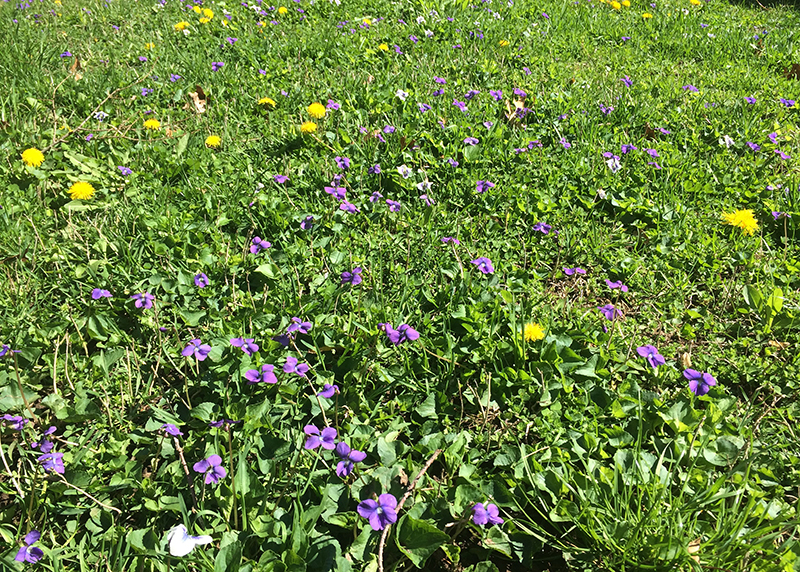If you’re ready to re-think your lawn, read on for practical advice and small changes that can help support pollinators and a healthier planet.
A lush, green, weed-free lawn is as American as apple pie. It tells the whole neighborhood that you are a competent, hard-working, contributing member of society. Dandelions and an overgrown lawn are a sign of neglect, incompetence, and laziness—or so our culture would have you believe.
Americans have a love affair with lawns—maintaining roughly 40 million acres, making them the single largest irrigated crop we grow. We are mowing it, raking it, fertilizing it, and watering it weekly—sucking up time, money, and other resources. If you’re ready to re-think your lawn, read on for practical advice and small changes that can help support pollinators and a healthier planet.

Do More By Doing Less
Small gas-powered engines—such as those found in outdoor lawn and garden equipment—lack the emission reduction equipment found on larger engines. According to a 2001 study, operating a gas-powered lawn mower for one hour produces as much air pollution as a 100-mile car trip, and a 2011 test by automotive experts at Edmunds showed that a consumer-grade leaf blower emits more pollutants than a 6,200-pound 2011 Ford F-150 SVT Raptor. Riding mowers are nominally better than the two-stroke engines found on push mowers, but they still do not have to meet the same emission standards as cars. While electric and battery-operated equipment aren’t without their own environmental impacts, reducing the amount you mow will reduce emissions regardless.
In addition to reducing emissions, mowing your lawn less often can increase bee abundance and diversity, too. In a recent experiment conducted by Susannah Lerman, a research ecologist with the USDA Forest Service's Northern Research Station, and her collaborators explored whether different lawn mowing frequencies influenced bee abundance and diversity. The team mowed herbicide-free suburban lawns at different frequencies (every week, every other week, and once every three weeks) in Springfield, Massachusetts. The results of their study found bee abundance increased when lawns were mown every other week. Mowing every three weeks resulted in more than double the number of flowers available in lawns (mainly dandelions and clover), and increased bee diversity—yet lowered overall bee abundance versus the every-other-week strategy. The researchers hypothesize that, while the three-week mowing cycle left more flowers in the lawn, the length of the competing turfgrasses made the flowers harder to find. Lerman and her colleagues documented a staggering 93 species of bees, with supplemental observations bringing the total number to 111 bee species—nearly a quarter of all bee species native to the area!

The efficacy of this practice may be expanded upon by altering the composition of your lawn to include more flowers in your lawn. A “bee lawn” may include clover (which captures nitrogen and helps feed the lawn) as well as other low-growing flowering plants such as creeping thyme (Thymus spp.), self-heal (Prunella vulgaris), and others. Some plants, such as native violets (Viola spp.) may already be present and should be encouraged as they are valuable host plants for fritillary butterflies. For more information about creating a flowering lawn please see the resources at the end of this blog.
By reducing mowing frequency, you will also help your lawn become more resilient to drought. Mowing grass stimulates growth, requiring the plants to take up more nutrients and water to survive. Letting the lawn grow a bit longer will increase the amount of water the leaves can hold.
Go Lawnless
Lawn certainly has its place. It provides a perfect platform for kicking a ball around, provides “accommodation” for the needs of pets, and can be used to define space in landscape design. But how much lawn do you really need, and to what standard must it be maintained? Do your kids need a perfect, weed-free lawn to play on? Do you really need to measure your lawn in acres rather than feet? In addition to reducing the amount you mow – think about reducing the amount of lawn that needs mowing. In place of that lawn, consider planting a rain garden, pollinator garden, or wildflower meadow – or replacing your turf grass lawn with native lawn alternatives.
Mind the Mussels, Too!
A far less visible impact from the over-abundance of lawns is the downstream effects of chemical fertilizers and pesticides used on lawn. When applied to a lawn, any chemical fertilizers or pesticides not taken up by the grass can move through soil or surface water and end up in local watersheds. The effects of synthetic fertilizers and herbicides on aquatic ecosystems can be far-reaching, affecting reproduction, growth, and development of sensitive aquatic invertebrates such as mayflies and freshwater mussels.
In place of chemical fertilizers, consider top-dressing your lawn with a thin layer of compost in spring and leave your grass clippings on the lawn after you mow to provide slow-release access to nitrogen and other nutrients. If you choose to apply fertilizers, either organic or synthetic, follow instructions and do not over-apply—more product does not mean better results. Both organic and synthetic fertilizers should only be applied when grass is actively growing, not too early in the spring nor late in the fall to increase the amount these products are taken up by hungry plants and reduce the amount that’s washed away.

What About Weed Regulations?
Most cities and municipalities have some form of weed ordinance that dictates the height and sometimes even the types of plants a homeowner is allowed to grow. Unfortunately, many of these ordinances are woefully out of date and out of touch with the modern movement towards creating yards that support wildlife in urban settings. While local ordinances will vary greatly from place-to-place, here are a few tips for keeping local officials, and your neighbors happy:
- Maintain a mowed buffer. Yes—after spending a considerable amount of time discussing the problems with lawn, we are suggesting you keep some—strategically. Keeping a mowed edge in front of or around a natural planting of a foot or two may be all that’s needed to define “lawn” from “garden” and keep you in step local ordinances or Homeowner Association guidelines. Maintaining a tidy mowed edge also makes a busy natural planting look less overwhelming, and makes these spaces look intentional rather than neglectful.
- Engage with your city council, health department, or other local officials. Tell them what you are doing, why, and begin a conversation about how they can support natural landscapes in their community. This fact sheet from Penn State can help arm you with facts to overcome the common myths that have led to overly restrictive weed ordinances.
- Suggest an “opt-in” program, such as a Natural Lawn Registration program to sidestep the need to re-write health code ordinance. Under such a model, a homeowner may register their natural landscape with their local health department. The health department can then decline to fine registered properties as long as they are maintaining the natural landscape properly and not encouraging the spread of noxious weeds.
Love your lawn a little less, and the bees will love you for it!
Resources
Lawn mowing frequency affects bee abundance and diversity in suburban yards
BlueThumb.org: Pollinator-Friendly (Bee) Lawn: http://www.blue-thumb.org/turfalternatives/pollinator-friendly-bee-lawn/
University of Minnesota Bee Lab: http://blog-yard-garden-news.extension.umn.edu/2012/03/a-bee-lawn-how-to-have-insect-haven-in.html




